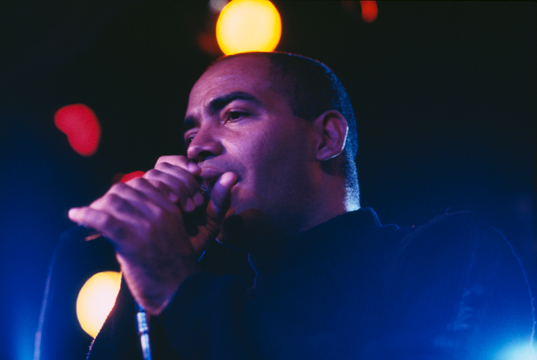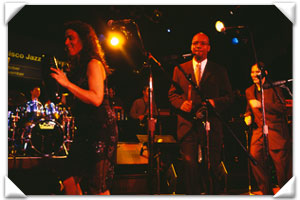Indice - Table of contents
Lo Nuevo[hide]
Reportes: From The St... : Cubadisco 2...
Tienda: Cuban Music Store
Reportes: From The St... : Cubadisco 2...
Fotos: Tom Ehrlich
Staff: Kristina Lim
Musicos: Juan Formell
Musicos: Yordamis Megret Planes
Musicos: Yasser Morejón Pino
Musicos: José Luis "Changuito" Quintana...
Musicos: Dennis Nicles Cobas
Fotos: Eli Silva
Grupos: Ritmo Oriental : 1988 - Vol. IX - 30 a...
Musicos: Rafael Paseiro Monzón
Musicos: Jiovanni Cofiño Sánchez
Fotos Del Día [hide]
SpanishEnglishConc. Report - San Francisco Jazz - 2001 - Manolín Live in SF, pt. 2
El Club Los dos éxitos de taquilla fueron los primeros espectáculos de Timba para el Club Bimbo 365, en la pintoresca North Beach, en San Francisco. Este no era un lugar agradable, lo cual dio lugar a múltiples quejas de los asiduos de la Timba de SF, pero si sólo se tiene en cuenta sus propiedades acústicas éste es, sin lugar a dudas, el mejor escenario de la Timba en California del Norte, excluyendo por supuesto a Yoshi y al Kuumbwa Jazz Center, que desafortunadamente no ha presentado espectáculos de Timba, ni siquiera cuando los grupos venían frecuentemente. Bimbo's tiene un sistema de refuerzo del sonido relativamente bajo. En los últimos años yo he participado en más de 200 espectáculos en vivo de Timba y estos dos fueron de los pocos conciertos en los que el sonido no fue de ninguna manera ni muy alto ni distorsionado. Para explicar mejor este fenómeno maravilloso e inesperado hay que darle los créditos al operador de sonidos, el cual mostró su capacidad de monitorear los decibeles y un hábil uso de la “estructura de ganancia”. Desafortunadamente, la Timba estaba en un territorio no familiar en términos de la mezcla. Frecuentemente el piano estaba demasiado bajo y lo que es peor, casi no se oía la espectacular conga de Tomás Cruz. SIN EMBARGO, las voces, las trompetas y todos los matices sutiles de la batería de Guerra fueron brillantemente reproducidos, aproximándose a la calidad de un CD. Usualmente, el sonido en los conciertos latinos es tan horrible que la mejor estrategia es abarrotar el escenario y tratar de disfrutar del sonido directo de los músicos más próximos. En este caso, dos tercios de los participantes pudieron sentarse por detrás y disfrutaron de un espléndido sonido estéreo mezclado. La entonación de los coros y metales, mucho mejor que la promedio, es un indicador de que el monitoreo sobre la escena fue también bueno, a pesar de que Bimbo no posee el increíble sistema de monitoreo en el oído, usado por Willie Chirino y Luis Enrique para producir efectos especiales. Me parece que ningún club posee tales sistemas, de modo que en ellos sólo pueden tocar los grupos suficientemente pudientes que poseen estos sistemas y pueden traerlos consigo. Sin lugar a dudas, el monitoreo es el futuro y va a mejorar drásticamente la calidad de las actuaciones en vivo de los latinos en los próximos años, en la misma medida en que tales sistemas se vuelvan más asequibles. La Música Cada noche el conjunto presentó una colección extensa de casi 2 horas y más de una docena de canciones. El grupo ha evolucionado en una dirección contraria a la tendencia de la Timba, que se caracteriza por arreglos cada vez más largos. El conjunto de Manolín toca dos piezas en el tiempo que Issac, Paulito o LW terminan sólo una. Esta propuesta es extremadamente efectiva y es una de las mejorías que ha introducido Manolín respecto a sus presentaciones en Cuba en los últimos años. La fuerza de esta agrupación está en los textos, los arreglos y la explosiva sección rítmica. A diferencia, por ejemplo, de Mayito Rivera o Issac, Manolín no tiene la fuerza vocal necesaria para improvisar por períodos de tiempo largos, sin embargo dentro de este formato de ritmo rápido, Manolín sonó fuerte y claro, mucho mejor que todo lo que yo le había escuchado en conciertos anteriores. En los últimos años en Cuba él lucía distraído y fuera de lugar, pero ahora es intenso y profesional y trabaja sobre sus limitaciones vocales, maximizando el efecto de sus textos brillantes y cálidos y de su personalidad carismática.
Manuel González Hernández, El Médico de la Salsa
Manteniéndose en el espíritu del Festival de Jazz de SF, el grupo inició la presentación con un instrumental corto y continuó interpretando una pieza de Jazz latino, poderosa y extendida, que incluyó solos de cada uno de los miembros del conjunto. Ambas noches esto resultó muy excitante y esperamos que se convierta en un rasgo regular de las actuaciones del grupo.
La presentación larga y a buen paso incluyó tres de las mejores piezas de "Para Mi Gente" (1996): "Voy a Mí", "Me Pasé de Copas", y una versión actualizada de la canción más famosa de Manolín: "La Bola". Además se incluyeron 4 piezas de su obra maestra de 1997 "De Buena Fe": "Somos lo que Hay", "No Lo Comentes", "Él Que Esté que Tumbe", y la pieza interpretada al solicitárseles una repetición, "Pegaíto, Pegaíto", que también luce un nuevo final. El resto del material fue posterior a "De Buena Fe". Aunque Manolín no ha grabado ningún álbum desde 1997 debido a problemas con los contratos de grabación, ha agregado por lo menos 15 canciones nuevas y buenas a su repertorio, las cuales son tan bien conocidas en Cuba que Issac Delgado ha usado algunos de los coros (como homenaje) en presentaciones en vivo. Existe una versión pirata, ampliamente circulada, de un compendio de piezas que no está completo y no incluye una pieza fantástica y exaltada que Manolín interpretó las dos noches (y cuyo título correcto desconozco).
Manolín omitió varias canciones nuevas que ya había interpretado en Miami durante este verano. Este material, en tanto que pop fuerte, tiene poco de la Timba dura del resto. Probablemente Manolín sintió que la zona de la bahía sería más receptiva a un acercamiento a la Timba pura, a diferencia de Miami, que al menos en la superficie tiende a un estilo mucho más homogeneizado de pop latino. Yo le pregunté al tecladista y arreglista Luis Bu acerca de cuando saldría el nuevo arreglo sobre el tema "Somos lo que Hay" y él dijo algo de que Sony Records está más interesada en el pop. Entonces, ¿por dónde seguirá Manolín en lo adelante? Él se las ha arreglado para mantener una de las mejores agrupaciones de Timba fuera de Cuba, que sigue interpretando una Timba vibrante y sin adulteraciones, reuniendo al menos una cantidad razonable de trabajo. Pero, ¿continuará produciendo más material nuevo que sea tan innovador y poderoso como todo su trabajo (grabado y no grabado) de los últimos 6 años?. Eso hay que verlo todavía. Aquí en timba.com incluiremos una extensa serie de páginas sobre la historia y la música de Manolín y su grupo hasta el momento, y probablemente tendremos pronto algún "chisme" interesante sobre sus planes futuros. Por ahora, debemos estar agradecidos de que la "Yuma" tenga acceso al menos, a una de las grandes agrupaciones de Timba, sin perder las esperanzas de que esta no se disuelva, debido al lamentable estado del pop latino que actualmente domina los medios en nuestro país.
El Acto de Apertura
Ambas noches el espectáculo fue iniciado por el conjunto de la zona de la bahía "Jesús Díaz y su QBA". Díaz llegó de Cuba a inicios de los 80 y rápidamente se convirtió en uno de los congueros más importantes del país. Canta a la cabeza del grupo mientras toca la campana magistralmente y hace que esto parezca algo fácil. Pero el que haya tratado de imitarlo alguna vez sabe que es todo lo contrario. QBA sacó a luz pública su primer álbum "Caramelo" en 1999 y está a punto de sacar el segundo.

Jesús Díaz y su QBA
El grupo cuenta con el increíble Carlos Caro en los timbales. Caro tocó durante años con Paulito FG antes de abandonar la isla a mediados de los 90. Además de su trabajo con QBA, él es el director musical del otro grupo de Timba de acá, Chambo. Otro intérprete sobresaliente es Marco Díaz, uno de los pocos pianistas norteamericanos que ha aceptado el reto de los avances en la interpretación de los montunos que se han producido en Cuba en la última década. Díaz ha dominado la técnica de "correr la mano izquierda" popularizada por Iván "Melón" González. Cada mano toca un ritmo sincopado diferente y el resultado es rítmicamente irresistible. En varios momentos de la pieza, muy bien ensayada, el bajista Saul Sierra se retira para darle relevancia al piano.
Para más información sobre QBA, visite su website.
El Fotógrafo:
Peter Maiden es uno de los líderes mundiales de la fotografía sobre la música Latina. Para ver más ejemplos de su trabajo increible, visite su sección de timba.com y su website.

















